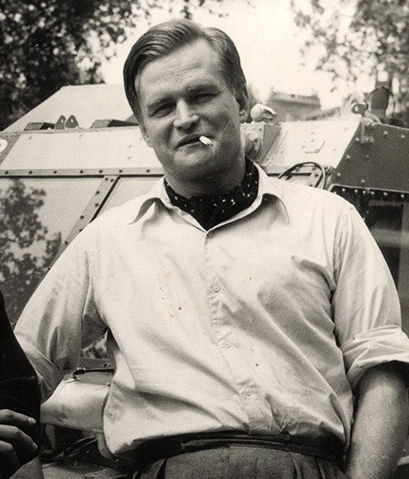
Ben Carlin in Montréal, 1948 (Source » Wikipedia)
In 1948, with dreams of fame and fortune, a young Australian mining engineer and his American wife set out to circumnavigate the world, by land and sea, in a single vehicle.
The vehicle in question was an amphibious jeep developed by the U.S. Army, which Carlin named Half-Safe. It was a mechanical cross-breed that was supposed to move with equal ease across land and water but in practice wasn’t much good for either.
Ben Carlin and his wife Elinore started their adventure from Montréal, sailing across the Atlantic Ocean to the Sahara Desert.
10 years later, upon returning to Montréal on May 12, 1958, Frederick Benjamin Carlin became the first person to circumnavigate the world in an amphibious vehicle.
The extraordinary adventure had covered 17,780 km (11,050 mi) by sea and 62,744 km (38,987 mi) by land, crossing three oceans and passing through 38 countries over five continents.
(Videos below)
YouTube »
Sparked by an idea he had had whilst in the military, Carlin proposed that the couple honeymoon by crossing the Atlantic Ocean in a modified Ford GPA (an amphibious version of the Ford GPW Jeep), which they named the Half-Safe.
Beginning their trip in Montreal, Canada, the Carlins finally completed the transatlantic crossing in 1951, after unsuccessful attempts. From there, they travelled to Europe, temporarily settling in Birmingham to raise more money.
They resumed their journey in 1954, traveling overland through the Middle East before arriving in Calcutta.
After a short fundraising trip to Australia, Carlin’s wife left to return to the United States.
He resumed the journey with new partners, traveling through South-East Asia and the Far East to the northern tip of Japan, and then to Alaska.
After an extended tour through the United States and Canada, he and Half-Safe finally returned to Montreal, having travelled over 17,000 kilometers (11,000 mi) by sea and 62,000 kilometers (39,000 mi) by land during a ten-year journey.
Following Carlin’s death in 1981, Half-Safe was acquired by Guildford Grammar, his old school, where it remains on display.
More »
- Wikipedia
- The Man Who Drove Around The World (James Nestor, HuffPost)
This page was last updated on 2021.07.20